By Tamara Marshall Whiting

A trio of hemlocks in Pisgah National Forest, left, have succumbed to the woolly adelgid infestation. Photo by James M. Davidson. At right, the Grandfather Golf and Country Club in Linville, N.C., has installed a lightning rod to protect an old hemlock. Photo by Jim Magruder
“The world is changed. I feel it in the water. I feel it in the Earth. I smell it in the air. Much that once was is lost….” These are the words of Galadriel the elf in the opening scene of the first movie in the “Lord of the Rings” trilogy. These words, spoken in a work of fantasy, speak to a sad reality facing the Eastern and Carolina hemlock trees of the southern Appalachian Mountains today; many are passing away, dying before my eyes. I know this because I love these mountains and I have spent years hiking in her forests. But recent years hiking in these mountains have taken me on an unexpected journey into the noble efforts of many people to save our hemlock trees.
The survival of these trees is threatened by the hemlock woolly adelgid, an invasive insect that reached the West Coast on plants imported from Japan in the 1920s, and was found in the eastern United States near Richmond, Va., in the early 1950s.
The grandest of the two is the Eastern hemlock, often referred to as “the redwood of the East.” These trees can stand over 150 feet tall, their breadth can be over six feet in diameter, and their lifespan can reach upwards of 600 years. Eastern hemlocks have stood as giant citadels, proud citizens of these mountains. But today, many are skeletons of what they once were, with sagging branches drained of their sap — needleless and dying.
Eastern hemlocks are a dominant tree in the eastern United States, extending up the Appalachian Mountains from northern Georgia and Alabama to Maine and as far west as Minnesota. Carolina hemlocks, their shorter cousin, are predominantly found in North Carolina and neighboring states.
I first became aware of the hemlock plight in 2013 while hiking to Helton Falls near Blood Mountain, Ga. As I descended the path to the falls, it became clear that something was terribly wrong. It looked like a chainsaw massacre had taken place — great big trees lay on the ground where they fell, with wide stumps left beside the path.
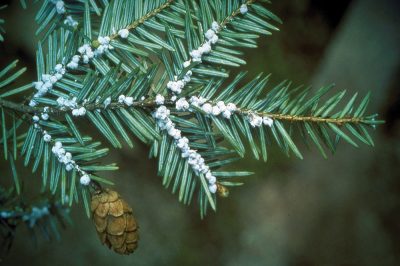
A hemlock woolly
adelgid infestation on a branch can be identified by the pest’s white “woolly” clusters of eggs.
Photo by Connecticut Agricultural Experiment Station Archive
When I examined the wood it did not look diseased or hollow. The destruction looked so needless. I called the Georgia Forest Service after the hike and was told that the trees were weakened by the hemlock woolly adelgid and were dying, and that they had to be cut down for the safety of hikers.
So I researched the hemlock woolly adelgid, an aphid-like insect the size of the period at the end of this sentence. Woolly adelgids locate themselves near the bark at the base of a hemlock tree’s needles and suck out the sap. Over time, an infestation of these insects consumes the entire tree’s nutrition, leaving nothing for the tree itself.
After infestation takes hold, a tree cannot produce new growth. It loses all its needles, and often dies within three to five years. If a tree survives the effects of the adelgids, it is still greatly weakened and usually dies from secondary causes.
It is easy to spot an infestation on a hemlock tree; it looks like waxy tufts of white wool stuck to the underside of the branches. Hemlocks that become stricken with the insect also change color — their needles fade to gray from the dark, rich green of healthy hemlocks and eventually fall off.
The hemlock woolly adelgid has now infested almost the whole Appalachian mountain chain.
Saving Hemlock Trees
The efforts of many people working together are protecting hemlock trees across our national and state parks and forests. Efforts are being made on private lands as well, including country clubs, college campuses and individual backyards. University researchers, public employees, nonprofit staff and citizen volunteers are all contributing their time and skill, including at some of the public lands I’ve explored in recent years.

Forester Jesse Webster checks for the presence or absence of Laricobius beetles, which feed on the hemlock woolly adelgid, at a hemlock conservation site. Photo by Mike Belleme
In early June of 2016, I was hiking the Hemlock Nature Trail along the James Fork River in South Mountain State Park near Morganton, N.C. As I walked I noticed many young hemlock seedlings alongside it, but closer to the river I observed one diseased older hemlock after another towering into the air, infested and dying or already dead.
A sign alongside the trail explained that the hemlocks were being treated with a method called soil drench, which involves digging a trench near the base of a mature tree and filling the trench with a liquid pesticide mixture that can be taken up into the tree through its root system.
The pesticide eventually kills the adelgids while they feed on the tree, but does not harm the tree itself. This treatment has to be repeated every four to six years for the lifespan of the tree.
I caught up with the South Mountain rangers in May 2017 and asked them how their efforts were going. “The trees that have been treated are recovering,” Ranger Mark Sain said confidently, “but the older hemlocks that you noticed last year that were dead or dying were too close to the river to be treated with the method we have been using. The river would be contaminated from the pesticides if we treated them.”
In the Great Smoky Mountains National Park, forester Jesse Webster leads a team of trained technicians to fight infestations of the hemlock woolly adelgid close to water sources by hiking off trail, sometimes deep into the forest, to pump a pesticide mixture directly into infested trees.
This process has to be repeated every five to seven years. The tree injection system is being used to treat hemlocks in other large areas like Big South Fork National River and Recreation Area in Tennessee and Kentucky. But this technique requires skilled technicians and is more expensive than other treatments.
Biological Predators
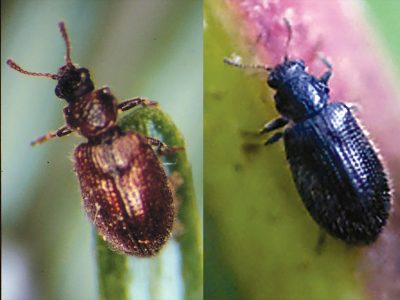
Predatory beetles L. nigrinus and L. osakensis have been introduced to combat the adelgid. (Photo credits: Tom McAvoy, Virginia Polytechnic Institute and State University, Bugwood.org; Courtesy of National Park Service)
In 2002, two foreign species of beetles — Sasajiscymnus tsugae from Japan and Scymnus sinuanodulus from China — were introduced into the Tennessee side of Great Smoky Mountains National Park to prey upon the hemlock woolly adelgid. According to Webster, however, this first effort brought scant results.
A new effort was made there with two different predator beetle species in 2006 and 2007 — Laricobius osakensis from Japan and Laricobius nigrinus from the Pacific Northwest — with much better results.
“We were able to go back two and three years later and find the next generation of beetles actively feeding on [the adelgids],” Webster explains. “And that was very encouraging.”
According to Webster, biological releases have been done every year since — the most recent was this past November. He explains that L. nigrinus and L. osakensis beetles seem to establish most easily and continue to be the most successful beetles in preying on the hemlock woolly adelgid. “Not enough yet,” Webster commented, “but they are there on the landscape and growing.”
A 2014 USDA Forest Service study in collaboration with the University of North Carolina, Asheville, and the University of Tennessee, Knoxville, in northern Georgia documented that L. nigrinus beetles are beginning to reduce the population of hemlock woolly adelgids when used in combination with soil injection treatments.
In the beginning, Webster experienced resistance about releasing these non-native beetle species into the park. Some scientists, ecologists and concerned citizens were afraid that they could cause more problems than they would solve. The kudzu vine, for example, was introduced to stop erosion but quickly proved to be an aggressive invasive species. But, according to Webster, once the general public learned about the detailed scientific scrutiny that must be done before any new species is introduced into a landscape, most people realized that the low risk of negative ecological impacts was worth taking, considering there was a strong possibility of saving trees.
Predator beetles have since been released in many locations. In the fall of 2017 alone, the U.S. Forest Service and state partners released 13,000 beetles in the Northeast and mid-Atlantic and 10,000 in Southern Appalachia.
Cumberland Plateau of Tennessee
On the Cumberland Plateau, the presence of the hemlock woolly adelgid has been relatively recent. In South Cumberland State Park the pest was first discovered in 2012 in Marion County, Tenn., and has since expanded into the three adjacent counties included in the park.
The soil injection treatment has been used extensively in the park since 2013. I spoke with South Cumberland State Park Manager George Shinn this last July and he told me that “every tree 10 inches in diameter and bigger within 300 feet on both sides of major drains (ravines and waterways) that could be treated was treated.” He explained that the trees have been recovering well and the spread of the adelgid has slowed due to the park’s quick response upon first detection of the pest.
[captio
According to The Nature Conservancy, the presence of the hemlock woolly adelgid has been confirmed in most counties on the Cumberland Plateau, though its range is spotty. The Nature Conservancy, along with state and federal agencies and other partners, have treated thousands of trees in their efforts to stop the adelgid’s spread across the plateau.
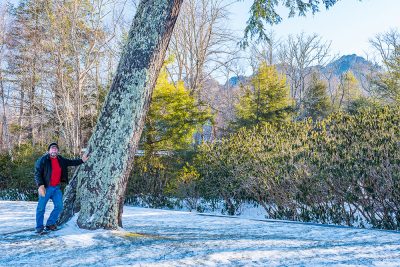
The hemlock woolly adelgid arrived at Grandfather Golf and Country Club in North Carolina in 2001. The club’s Pete Gerdon, above, first fought the adelgid with chemical treatments. Later, he collaborated with Watauga County entomologist Richard McDonald to introduce a beetle from the Pacific Northwest that feeds on the pest; he considers the beetle a great success. Photo by Jim Magruder.
In the lower elevation areas of the park’s Savage Gulf, there still exists one of the most impressive old-growth hemlock forests in the southern range of the species: the Werner Timber Tract. In November 2016, I looked down on this amazing forest from a vantage point on the ridge above, happy that this area appeared to be healthy and untouched by the spread of the hemlock woolly adelgid.
But after speaking with George Shinn, sadly I learned that the insect had been detected in the Werner Timber Tract that same fall, unknown to me as I was looking down with such awe upon it.
According to Shinn, two releases of predator beetles were done in the tract as soon as the infestation was noticed. I spoke with him again recently, and learned that another release was done in fall 2017. While Shinn stated that it is too early to make any conclusion about how the treatment is going, he is hopeful about its success.
Climate Change and Its Effects
Long term climate and precipitation research has been done by the U.S. Forest Service at the Coweeta Hydrologic Laboratory Southern Research Station near Otto, N.C. These studies conclude that, as a result of climate change, the southern Appalachian Mountains are becoming warmer and drier, with more frequent and severe droughts.
These conditions are encouraging the expansion of the adelgid and are making the battle against this insect tougher. Cold winter temperatures used to reduce their numbers seasonally. With warmer winter temperatures, this check in their population is lessening. And scientists agree that weather extremes will continue to be more intense and more frequent into the future.
“Drought stresses trees and inhibits their ability to confront insect damage,” Jesse Webster explained. “Drought may not facilitate the spread of [the hemlock woolly adelgid] but it definitely speeds mortality of the trees. During drought hemlocks produce very little new growth, and what little is there is more likely to be completely infested and just drop.”
And when other pests like the hemlock borer attack the same weakened tree, it can die in as little as three years in drought conditions.
Large stands of eastern hemlock trees have already died in the southern Appalachians. Despite the fact that many hemlocks have been treated and saved in state and national parks, this die-off will continue. A 2012 U.S. Forest Service and Western Carolina University study projects that in the future the absence of the eastern hemlock will cause significant changes in the structure and health of southern Appalachian forests.
Stands of eastern hemlocks provide important habitats and shelter for many creatures. Hemlocks grow along streams and rivers, forming thick canopies that keep water temperatures cool for aquatic animals and trout. With the loss of hemlocks and the dense shade they provide combined with rising temperatures from climate change, scientists project that stream temperatures will increase, reducing the native trout habitat and leaving them with the ability to survive in only a few refuges in higher altitudes.
Once hemlocks die, the space they leave behind will be filled by other species. One 2012 study from the U.S. Forest Service and Texas A&M University examined a portion of Pisgah National Forest in North Carolina and forecasted an increase in pine and oak as hemlocks decline. Another 2012 study from the U.S. Forest Service and Virginia Tech anticipates a large increase in rhododendron. This study projects that more extensive rhododendron thickets may be the greatest negative ecological impact of the loss of hemlock trees since they slow the growth of other species.
The littering of streams with needles and branches from dead hemlock trees will also affect nitrogen levels and stream structure. And without the shade and root systems that hemlocks have historically provided near rivers and streams, more light will reach the forest floor, moisture will be lost and a continued drying will happen in the forests.
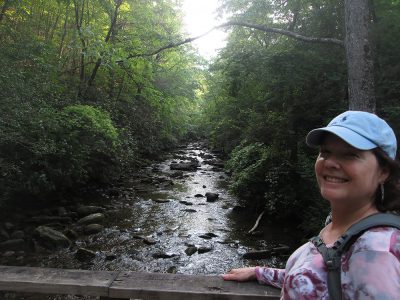
The author, Tamara Marshall Whiting, hikes at South Cumberland State Park, which is also fighting the woolly adelgid.
This is how nature works. Everything is connected. The demise of the hemlock trees is likely to cause a great loss of diversity. Every life affects another, and every death can cause the dying of others.
The world has changed. This death and dying impacts me profoundly. But the saving is as profound. As I hike and gaze up at healthy majestic hemlocks that still live and grace our land, I have renewed hope for the resilience and continued presence of this amazing tree in these, my beloved mountains. I am grateful for each tree that has been saved, those that will be saved and the people who are working tirelessly to save them.
Related Articles
Latest News

Leave a comment
Your email address will not be published. Required fields are marked *
2 responses to “Can We Save the Mighty Hemlock?”
-
Has anyone tried using large amounts of just plain sulfur around the tree bases? You’d think this would be more affordable and readily accessible and more natural on the tree In theory this could act as a natural pesticide. Worth the try.
-
I would like to know if the insect kills all the hemlock trees in a area. Do they also die off.


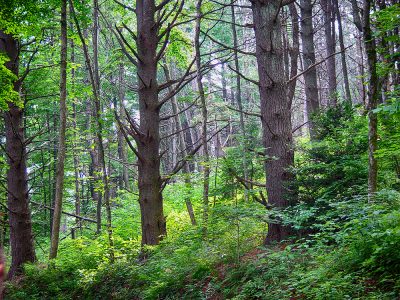



Leave a Comment